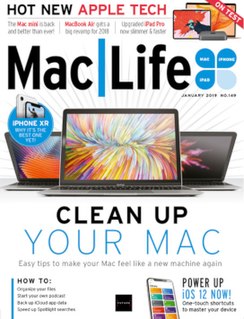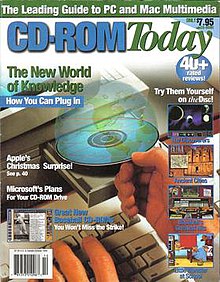
The Compact Disc-Interactive is a digital optical disc data storage format that was mostly developed and marketed by Dutch company Philips. It was created as an extension of CDDA and CD-ROM and specified in the Green Book, co-developed by Philips and Sony, to combine audio, text and graphics. The two companies initially expected to impact the education/training, point of sale, and home entertainment industries, but CD-i eventually became best known for its video games.

Mac OS 9 is the ninth and last major release of Apple's classic Mac OS operating system. Introduced on October 23, 1999, it was promoted by Apple as "The Best Internet Operating System Ever", highlighting Sherlock 2's Internet search capabilities, integration with Apple's free online services known as iTools and improved Open Transport networking. While Mac OS 9 lacks protected memory and full pre-emptive multitasking, lasting improvements include the introduction of an automated Software Update engine and support for multiple users.

MacLife is an American monthly magazine published by Future US. It focuses on the Macintosh personal computer and related products, including the iPad and iPhone. It’s sold as a print product on newsstands, and an interactive and animated app edition through the App Store. Between September 1996 and February 2007, the magazine was known as MacAddict. In Germany, a magazine of the same name but with no association is published by Falkemedia from Kiel.

The Net Yaroze is a development kit for the PlayStation video game console. It was a promotion by Sony Computer Entertainment to computer programming hobbyists which launched in June 1996 in Japan and in 1997 in other countries. It was originally called "Net Yarouze", but was changed to "Net Yaroze" in late 1996. Yarōze means "Let's do it together".

Basilisk II is an emulator which emulates Apple Macintosh computers based on the Motorola 68000 series. The software is cross-platform and can be used on a variety of operating systems.

Norton Utilities is a utility software suite designed to help analyze, configure, optimize and maintain a computer. The current version of Norton Utilities is Norton Utilities 16 for Windows XP/Vista/7/8 was released 26 October 2012.

The Power Macintosh 6100 is a personal computer designed, manufactured and sold by Apple Computer, Inc. from March 1994 to March 1996. It is the first computer from Apple to use the new PowerPC processor created by IBM and Motorola. The low-profile ("pizza-box") case was inherited from the Centris/Quadra 610 and 660AV models, and replaced the Macintosh Quadra series that used the Motorola 68040 processor, Apple's previous high-end workstation line.

Mario's Game Gallery is a compilation of games published by Interplay Productions and developed by Presage Software, Inc. for DOS, Windows and Macintosh. It was released in 1995 in the United States. It was later re-released as Mario's FUNdamentals for Macintosh in 1996, and for Windows in January 1997, though it was published by Mindscape for the DOS and Windows versions and by Stepping Stone for the Macintosh version. It was also developed by Brainstorm Entertainment.
The Amiga computer can be used to emulate several other computer platforms, including legacy platforms such as the Commodore 64, and its contemporary rivals such as the IBM PC and the Macintosh.

The Power Macintosh 9500 is a personal computer designed, manufactured and sold by Apple Computer, Inc. from June 1995 to February 1997. It is powered by a PowerPC 604 processor, a second-generation PowerPC chip which is faster than the PowerPC 601 chip used in the Power Macintosh 8100. The 180MP and 200 MHz models, introduced August 1996, use the enhanced PowerPC 604e processor.
Mac gaming refers to the use of video games on Macintosh personal computers. In the 1990s, Apple computers did not attract the same level of video game development as Microsoft Windows computers due to the high popularity of Microsoft Windows and, for 3D gaming, Microsoft's DirectX technology. In recent years, the introduction of Mac OS X and support for Intel processors has eased porting of many games, including 3D games through use of OpenGL and more recently Apple's own Metal API. Virtualization technology and Boot Camp also permit the use of Windows and its games on Macintosh computers. Today, a growing number of popular games run natively on macOS, though as of early 2019, a majority still require the use of Microsoft Windows.

The Power Macintosh 7300 is a personal computer designed, manufactured and sold by Apple Computer, Inc. from February 1997 to November 1997. It was introduced with 166, 180 and 200 MHz CPUs in February 1997 alongside the Power Macintosh 8600 and 9600. The 7300 replaced both the Power Macintosh 7200 and 7600, replacing the only remaining first-generation PowerPC system in Apple's lineup. MacUser Magazine's review says the 7300 "offers the most satisfying improvement" of the new machines introduced in early 1997 due to a significant performance jump from its predecessors, as well as offering 50% faster CD-ROM and hard disk space. The 7300 was replaced by the Power Macintosh G3 desktop model in November 1997. Workgroup Server 7350 continued to be sold until March 1998 when the Macintosh Server G3 was introduced.

The Macintosh Quadra 630 is a personal computer designed, manufactured and sold by Apple Computer, Inc. from July 1994 to October 1995. It was introduced as the replacement for the Quadra 610, and was the least-expensive computer in the Macintosh lineup with prices starting at $1,199 USD.
The Macintosh LC 500 series is a series of personal computers that were a part of Apple Computer's Macintosh LC family of Macintosh computers. It was Apple's mid-1990s mainstream education-market Macintosh, featuring an all-in-one desktop design with a built-in 14" CRT display, CD-ROM drive, and stereo speakers. Designed as a successor to the compact Macintosh family of computers, the case is similar to the then recently introduced Macintosh Color Classic, but considerably larger and heavier due to its larger screen and a bulging midsection to house the larger electronics.

The Journeyman Project 3: Legacy of Time is a computer game developed by Presto Studios and is a sequel to The Journeyman Project and The Journeyman Project 2: Buried in Time.
A web browser is a software application for retrieving, presenting and traversing information resources on the World Wide Web. It further provides for the capture or input of information which may be returned to the presenting system, then stored or processed as necessary. The method of accessing a particular page or content is achieved by entering its address, known as a Uniform Resource Identifier or URI. This may be a web page, image, video, or other piece of content. Hyperlinks present in resources enable users easily to navigate their browsers to related resources. A web browser can also be defined as an application software or program designed to enable users to access, retrieve and view documents and other resources on the Internet.

The Apple Pippin is a defunct open multimedia technology platform, designed by Apple Computer, and marketed as PiPP!N. According to Apple, Pippin was directed at the home market as "an integral part of the consumer audiovisual, stereo, and television environment."

The Macintosh is a family of personal computers designed, manufactured, and sold by Apple Inc. since January 1984.

The classic Mac OS is the series of operating systems developed for the Macintosh family of personal computers by Apple Inc. from 1984 to 2001, starting with System 1 and ending with Mac OS 9. The Macintosh operating system is credited with having popularized the graphical user interface concept. It was included with every Macintosh that was sold during the era in which it was developed, and many updates to the system software were done in conjunction with the introduction of new Macintosh systems.

A Passion for Art: Renoir, Cezanne, Matisse, and Dr. Barnes is a 1995 interactive CD-ROM by Corbis.
















